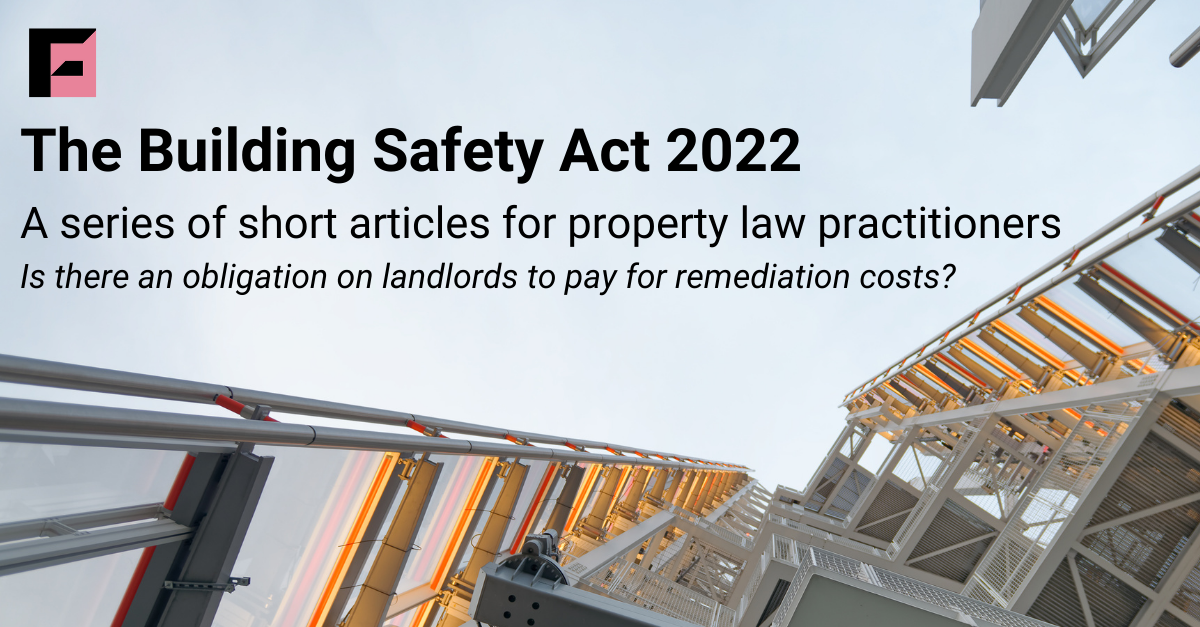The Building Safety Act 2022 - Is there an obligation on landlords to pay for remediation costs? 09 October 2023
- The aim of cladding remediation must be to ensure work is done and certain leaseholders do not have to pay the cost.
- The Building Safety Act 2022 itself does not impose duties on all landlords to remediate.
- There is a new duty on accountable persons for higher-risk buildings, but that does not apply to all the buildings on which service charge limitations have been introduced.
- The Act introduces remediation orders, but they give a discretion to FtTs to decide if a landlord should be ordered to remediate if an application is made.

Does the BSA impose an obligation on landlords to pay for remediation costs no longer recoverable through the service charge?
Since the Building Safety Act 2022 came into force, with its Schedule 8 prohibition on landlords recovering service charge for certain cladding and other defect remediation works, the Government has produced and updated guidance for leaseholders on whether they would have to pay for remediation and whether remediation works would be done. Some of that guidance does not sit easily with the effect of the Act, however.
For example, the 21 July 2022 DLUHC guidance “What are my building owner’s legal obligations?” (updated in August 2023) says this, for building owners who are not developers, in relation to qualifying leaseholders: “… your building owner … still [has] an obligation to pay all the costs associated with the remediation of cladding …” The difficulty with that proposition is that it assumes, as in the summary of the guidance, “Building owners must make their buildings safe” without tracing the sources of any such obligation and the ability of leaseholders to enforce them.
A not uncommon general issue for landlords and leaseholders is that the landlord’s maintenance obligations may not be drafted sufficiently widely to encompass all of the defects those parties might wish remediated. If the landlord has a repairing obligation only, he need not under the lease covenants remedy something which is a defect only, where there is no deterioration in the fabric sufficient for disrepair. Thus, in relation to the walls of a building, if the cladding is unsafe due to the material used, or the installation during construction, but there has been no deterioration in the cladding post installation, then the landlord may well not be under any leasehold obligation to do works. In that case, looked at from the perspective of leasehold covenants at least, it is wrong to say that the landlord must make the building safe, or indeed pay for the works. The landlord need only pay for works if he does them (and the question is then whether he can recover the cost through the service charge). He need only do the works if the leasehold covenants require him to do them. Outside the Building Safety Act 2022, leaseholders are often left unable to force landlords to do works because the leasehold covenants are limited, and if there are statutory obligations they may enforceable by the (cash strapped) local authority or similar only, not the leaseholders themselves.
Does the Building Safety Act 2022 change this so as to make remediation of cladding and the other risks caught by it more likely? Yes, but in two limited ways.
The Building Safety Act 2022 imposes a new statutory duty on certain landlords of higher-risk buildings within Part 4 of the Act. Part 4 applies to buildings at least 18m in height or with at least 7 storeys, containing at least 2 residential units. For such buildings, the Part defines the term “accountable person”, being (subject to some provisos in particular circumstances) a person with a legal estate in possession in any part of the common parts, or a person without a legal estate in any part of the building but who is under a relevant repairing obligation (under the lease or statute) in relation to any part of the common parts, such as a management company named in the flat leases. Part 4 then imposes various duties on accountable persons. One, in s84, is a statutory duty to take all reasonable steps to prevent a building safety risk materialising, or reducing the severity of any incident resulting from such a risk materialising. The steps may include carrying out works. The statutory duty may be an extension of the landlord’s leasehold obligation because it may be a greater obligation than an obligation to repair. Moreover under s112 of the 2022 Act and new s30B of the Landlord and Tenant Act 1985, the duty is a statutorily implied landlord covenant in each flat lease. However, the steps required are reasonable steps, so that this duty is not simply an obligation to make the building safe. “Reasonable” might in principle take into account the resources of the landlord to do works. In addition, the duty arises only in relation to higher risk buildings. For the lower height (at least 11m) or storeyed (at least 5 storeys) buildings in Part 5 of the Act but not Part 4, no such statutory duty is imposed.
The second way the Act might assist is via the new FtT jurisdiction to make remediation orders under s123. Such orders can require a landlord to remedy a relevant defect. Not all landlords are caught, the landlord must be “a landlord under a lease of the building or any part of it who is required, under the lease or by virtue of an enactment, to repair or maintain anything relating to the relevant defect”. This is a gateway condition. The landlord’s maintenance obligation, statutory or leasehold, does not appear to limit the jurisdiction of the FtT. Thus if the landlord has a repairing obligation only, the landlord may well not be under any leasehold obligation to do works to replace defective cladding if it is not in disrepair. Nevertheless, it appears that the landlord can be ordered to replace the cladding by the FtT by the making of a remediation order. The FtT appears to have a wide discretion whether to order remediation. However, the remediation order jurisdiction is not a simple solution requiring all landlords to carry out remediation works and pay their costs.
The Building Safety Act 2022 received Royal Assent in April 2022. It is seen as an “overhaul” of previous regulations and changes how residential buildings should be constructed, maintained and made safe. A group of Falcon Chambers barristers have studied the Act, analysed how it has been interpreted in courts and tribunals thus far, and have first-hand experience of BSA cases. In this series of articles Paul Letman, Catherine Taskis KC, Cecily Crampin, Camilla Chorfi and Julia Petrenko set out key issues property law practitioners should be aware about the BSA 2022.
Download: The Building Safety Act 2022 - Is there an obligation on landlords to pay for remediation costs?
Back to articles







